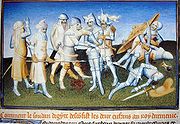
Battle of Mari
Encyclopedia

Egypt
Egypt , officially the Arab Republic of Egypt, Arabic: , is a country mainly in North Africa, with the Sinai Peninsula forming a land bridge in Southwest Asia. Egypt is thus a transcontinental country, and a major power in Africa, the Mediterranean Basin, the Middle East and the Muslim world...
and the Armenians of Cilician Armenia on August 24, 1266.
The conflict started when the Mamluk Sultan Baibars
Baibars
Baibars or Baybars , nicknamed Abu l-Futuh , was a Mamluk Sultan of Egypt. He was one of the commanders of the forces which inflicted a devastating defeat on the Seventh Crusade of King Louis IX of France and he led the vanguard of the Egyptian army at the Battle of Ain Jalut in 1260, which marked...
summoned the Armenian ruler Hetoum I to abandon his allegiance to the Mongols, and accept himself as a suzerain, and remit to the Mamluks the territories and fortresses Hetoum has acquired through his alliance with the Mongols.
Following these threats, Hetoum I went to the Mongol court of the Il-Khan in Persia to obtain military support. During his absence however, the Mamluks marched on Cilician Armenia, led by Al-Mansur Ali
Al-Mansur Ali
Al-Mansur Ali Al-Mansur Ali (Arabic: المنصور على ) Al-Mansur Ali (Arabic: المنصور على ) (epithet: Al-Malik Al-Mansur Nour al-Din Ali Ben al-Malik al-Mu'izz Aybak (Arabic: الملك المنصور نور الدين على بن الملك المعز أيبك ) (b. c. 1244, Cairo) was the second of the Mamluk Sultans of Egypt in the...
and the Mamluk commander Qalawun
Qalawun
Saif ad-Dīn Qalawun aṣ-Ṣāliḥī was the seventh Mamluk sultan of Egypt...
.
Hetoum I's two sons, Leo (the future king Leo II) and Thoros led the defense by strongly manning the fortresses at the entrance of the Cilician territory. The Mamluks, however, overtook the forts by going through the mountains, and encountered the Armenians at Mari, near Darbsak on August 24, 1266, where the Armenians were defeated. Leo was made a prisoner, and Thoros was killed in action. The Armeno-Mongol son of the Constable Sempad
Sempad the Constable
Sempad the Constable was a noble in Cilician Armenia, an older brother of King Hetoum I. He was an important figure in Cilicia, acting as a diplomat, judge, and military officer, holding the title of Constable or Sparapet, supreme commander of the Armenian armed forces...
, named Vasil Tatar, was also taken prisoner by the Mamluks and was taken into captivity with Leo, although they are reported to have been treated well.
Following their victory, the Mamluks invaded Cilicia, ravaging the three great cities of the Cilician plain: Mamistra, Adana
Adana
Adana is a city in southern Turkey and a major agricultural and commercial center. The city is situated on the Seyhan River, 30 kilometres inland from the Mediterranean, in south-central Anatolia...
and Tarsus
Tarsus (city)
Tarsus is a historic city in south-central Turkey, 20 km inland from the Mediterranean Sea. It is part of the Adana-Mersin Metropolitan Area, the fourth-largest metropolitan area in Turkey with a population of 2.75 million...
, as well as the harbour of Ayas
Ayas (city)
Ayas is a small town in Yumurtalık district, Adana Province, Turkey, located east of the mouth of the Ceyhan River. It was the ancient Aegea and medieval Ajazzo or Lajazzo. It passed between the Mamluks and the Armenians several times in the 13th and 14th centuries, and was definitively taken by...
. Another group of Mamluks under Mansur took the capital of Sis
Kozan, Adana
Kozan is a city in Adana Province, Turkey, 68 km north of the city of Adana, in the northern section of the Çukurova plain. The city is the capital of Kozan district. The Kilgen Stream, a tributary of the Ceyhan River , flows through Kozan crossing the plain south into the Mediterranean Sea....
. The pillage lasted 20 days, and 40,000 Armenians were made prisoners.
When Hetoum I arrived with Mongol troops, the country was already devastated. Hetoum I had to negotiate the return of his son Leo by giving control of Armenia's border fortresses to the Mamluks. In 1269, Hetoum I abdicated in favour of his son, and became a monk, but died a year later. Levon was left in the awkward situation of keeping Cilicia as a subject of the Mongol Empire, while at the same time he was paying tribute to the Mamluks.

